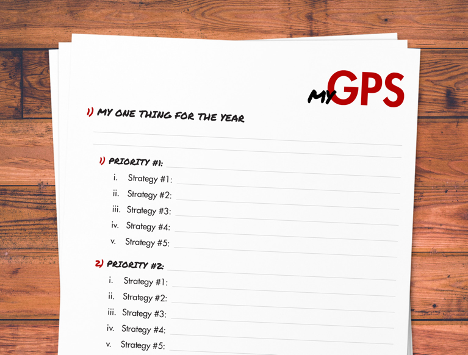Best Year Ever: Think Big With The GPS
“Annual goal setting shouldn’t be ‘What’s my goal this year?’ It should be ‘Where am I on the path to my end goal?’” – Gary Keller
It’s the new year and it’s time to move from inspiration to perspiration—to start taking the actions we need to move toward the outcomes we want. It’s time reach for your goals.
We’ve explained how Goal Setting to the Now can help you connect your future goals to the actions you need to take in the present to reach them, but we’re thrilled to show you another valuable tool that can place you (or your business) on the path to extraordinary results: the GPS.
At its simplest, the GPS stands for “goals, priorities, and strategies.” It’s a straightforward, no-frills plan for your life or your business. It looks at what you need to accomplish in the coming year so that it’s aligned with what you want to achieve in the future.
- Goal: What do you want to accomplish this year?
- Priorities: What key things will you need to focus on so that you can achieve your goal?
- Strategies: What actions are necessary to achieve each priority?
Let’s break down each of these components so you can see how they work together to build momentum for massive success:
Goals
Your GPS begins with your goal or goals. The biggest achievement or endgame that you’re striving for. You’ve likely heard of the SMART goal framework, which says that the best goals are Specific, Measurable, Actionable, Relevant, and Time-Bound, but we’d argue that there’s more to a goal than being SMART.
We encourage you to set BIG goals. In The Millionaire Real Estate Agent, Gary and Jay write that they “want you to think and believe big.” Setting a BIG goal will push you to create better models and systems along the way—that’s some major growth!
So what does this look like? Let’s say that in your professional world, your goal is to grow your consulting business by a certain year-over-year percentage. You might think that 5 percent growth is a “realistic” goal, but what would happen if you pushed for 10 percent? If you “failed” at the BIG goal and only increased your business by 7 percent, would that really be failure? Sometimes when we push ourselves for BIG goals, we fail our way to success.
Gary says that the purpose of a goal is that it shows you how to be appropriate in the moment. A GPS is an attack plan for a specific goal. If you’ve got a bunch of goals, you may need to create more than one GPS.
Priorities
Once you have established your BIG goal, it’s time to start creating the plan. This is where you’ll flesh out your priorities and strategies. The difference between a priority and a strategy is that a priority is what you want to achieve in a certain area (kind of like a mini-goal) and a strategy is how you plan on going that.
While there is no exact science to the number of priorities or strategies that will help you reach a specific goal, a good rule of thumb is to have approximately three priorities and five strategies per goal. In fact, you might have heard a GPS called a 1-3-5 before for this reason.
Let’s go back to that goal of growing your business by 10 percent next year. You might plan to achieve it by focusing on prospecting for new business, marketing for new business, and developing key relationships. These priorities will be accomplished with your strategies.
Strategies
The last little bit of the GPS goodness is the actions that you’ll take as you fulfill your priorities. Each of these strategies should ultimately move the needle for each priority and help you achieve the year-over-year growth you want.
If one of your priorities on your GPS was developing key relationships, your strategies might be identifying other businesses that you may want to co-host seminars or events with or scheduling a weekly time block for reaching out to your database.
Taken altogether, the GPS is a one-page action plan. It funnels your biggest goals into strategies that you can execute.
If you’re running a business, you’ll find the GPS can be incredibly helpful when planning for the year ahead with your team. Even if team members have drastically different roles, the GPS can show you—and them—where their responsibilities affect one another and contribute to the overall mis¬sion. With this clarity, you’ll be able to determine if too much or too little responsibility has been assigned to any one teammate.
The GPS is a valuable tool for communicating vision and aligning actions with expectations. You can find a template for creating your own GPS here. It is also the foundation for another valuable tool and habit—the 411. We’ll dive deep into how to hold a successful 411 in our next newsletter.


Love this!
This is awesome!
I just read the article on GPS. I’d like to read the one on 411